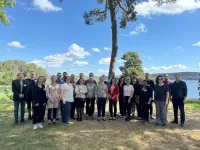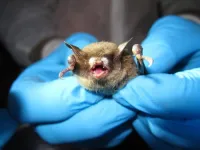(Press-News.org) EMBARGOED UNTIL 4 P.M. ET Thursday, July 11, 2024
Contact:
Jillian McKoy, jpmckoy@bu.edu
Michael Saunders, msaunder@bu.edu
##
As the oil and gas industry continues its rapid expansion throughout North America, a growing body of research has linked fossil fuel development to physical and mental health conditions during and after pregnancy, including preterm birth, birth defects, and psychological stress.
But it appears that oil and gas production may be hazardous to this population even before they become pregnant.
A new study led by Boston University School of Public Health (BUSPH) researchers suggests that people who are trying to conceive and live close to oil and gas development sites have a heightened risk of developing adverse mental health outcomes.
Published in the American Journal of Public Health, the study utilized data from participants in the BUSPH-based Pregnancy Study Online (PRESTO) and found that people who lived within roughly six miles of active oil and gas development had greater development of moderate-to-severe depressive symptoms, compared to people living 12 to 31 miles away from this activity. High perceived stress was elevated among people living just 1.25 miles away from oil and gas development, and greater intensity of oil and gas production also contributed to high perceived stress.
Prenatal and postpartum health challenges have captured national attention amid rising rates of US maternal morbidity and mortality, but these new findings call attention to the vulnerabilities of people during the preconception period—an otherwise understudied phase of the pregnancy process. It is the first study to assess the impact of fossil fuel development on pregnancy planners.
“Oil and gas development is a multifaceted exposure—it swiftly changes the economy, the social structures, and the environment in the community,” says study lead and corresponding author Dr. Mary Willis, assistant professor of epidemiology at BUSPH, who recently launched a database with an SPH team to show which communities are most affected by fossil fuel sites. “All of the changes may create stress and depression among local residents, an experience that may be particularly heightened among people trying to conceive. Identifying and mitigating potential hazards for mental health, like oil and gas development, is essential for facilitating a healthy pregnancy.”
For the study, Dr. Willis and colleagues analyzed mental health survey data and information from a national database of oil and gas development well locations in the US and Canada to identify potential connections between residential proximity to and density of active oil or gas development and psychological wellbeing among 5,725 PRESTO participants living in geographically diverse areas of the US and Canada. The team restricted the analysis to participants with household incomes below $50,000 to consider individuals who may not have the financial resources to move away from oil and gas activity if they choose.
To measure participants’ mental health status, the team posed clinical questions about recent stressful circumstances and depressive symptoms, as well as questions about medication usage for mental health conditions. Utilizing standardized metrics—rather than relying on mental health medical records, as the majority of studies do—likely captured instances of depressive symptoms that could have been overlooked in the absence of documented clinical care.
The “boom and bust” economic fluctuations associated with oil and gas development can lead to heightened stress among nearby community members, says study coauthor Erin Campbell, a research assistant in the Department of Epidemiology at BUSPH.
“The ‘boom’ periods could overload local infrastructure and social systems, while ‘bust’ periods could leave communities grappling with job losses and economic hardship,” Campbell says.
The study also found that many participants who reported elevated stress and depressive symptoms lived further away from oil and gas development than the minimum distance that many states now require to protect people in homes, schools, and health facilities. Although poor mental health was linked to PRESTO participants within approximately six miles of oil and gas activity for depressive symptoms, states such as Texas and Pennsylvania—where there is extensive oil and gas production—limit these “setback” minimum distances to as little as 200 feet.
The researchers hope this new insight shines a light on the less visible health impacts of resource extraction in local communities, and informs regulations for health-protective setback distances in residential areas.
**
About Boston University School of Public Health
Founded in 1976, Boston University School of Public Health is one of the top ten ranked schools of public health in the world. It offers master's- and doctoral-level education in public health. The faculty in six departments conduct policy-changing public health research around the world, with the mission of improving the health of populations—especially the disadvantaged, underserved, and vulnerable—locally and globally.
END
Living near oil and gas activity linked to poor mental health during preconception
A first-of-its-kind study suggests that living within six miles of active oil and gas production may lead to depressive symptoms among people trying to conceive
2024-07-11
ELSE PRESS RELEASES FROM THIS DATE:
WISDOM project pioneers plan to secure cross-border data sharing to combat chronic immune mediated diseases affecting 10% of Europeans
2024-07-11
Integrating medical and research data, ensuring secure data sharing, and using advanced AI models offer immense possibilities to mitigate the impact of chronic immune-mediated diseases (CIMDs) affecting 10% of Europeans. The consortium aims to transform complex biological information into actionable insights.
WISDOM believes novel computational tools can provide valuable knowledge and guide decision-making throughout the patient journey, from diagnosis to treatment optimization.
“As a key partner in the WISDOM project, the European Multiple Sclerosis Platform (EMSP) is committed to ensuring that patients' voices and perspectives are central to ...
$3 million federal grant to fund University of Montana research on bats, climate change
2024-07-11
MISSOULA – Since 2006, a fast-moving disease known as white-nose syndrome has killed an estimated 6.7 million bats, wiping out entire colonies and decimating creatures that provide an integral means of pest control.
In response, a first-of-its-kind study by the University of Montana recently was funded by the National Science Foundation to provide critical insights on three North American bat species that are adapting to the dual threats of this disease and climate change.
Awarded nearly $3 million dollars, the project will officially start Sept. 1, but groundwork already is well underway this summer.
Although infectious diseases occur naturally in wildlife ...
Scientific definition of a planet says it must orbit our sun; A new proposal would change that
2024-07-11
Key takeaways
The International Astronomical Union defines a planet as a celestial body that orbits the sun, is massive enough that gravity has forced it into a spherical shape, and has cleared away other objects near its orbit around the sun.
Scientists now recognize the existence of thousands of planets, but the IAU definition applies only to those within our solar system.
The new proposed definition specifies that the body may orbit one or more stars, brown dwarfs or stellar remnants and sets mass limits that should apply to planets everywhere.
Planetary scientists are proposing ...
Advanced imaging reveals how a parasitic ‘kiss’ alters cell metabolism
2024-07-11
Toxoplasma gondii is a parasite responsible for toxoplasmosis, a lifelong chronic infection prevalent in about 30% of the human population. It poses little harm to healthy individuals but can result in severe consequences for immunocompromised people. If infection occurs during pregnancy, the parasite can cross the placenta and cause retinal or neurological issues in the developing fetus, and potentially death in severe cases.
There is currently no vaccine for Toxoplasma infection, and the biological mechanism by which the parasite affects the metabolism of host cells is still understudied.
In new research ...
New medication for stress urinary incontinence? Investigational drug shows promise
2024-07-11
Waltham — July 11, 2024 — An investigational medication designated TAS-303 shows efficacy and safety in treatment of women with stress urinary incontinence (SUI), reports a placebo-controlled clinical trial in the August issue of The Journal of Urology®, an Official Journal of the American Urological Association (AUA). The journal is published in the Lippincott portfolio by Wolters Kluwer.
"Our study adds new evidence that TAS-303 reduces the frequency of incontinence episodes in women with SUI, without the worrisome adverse ...
Warm or cold: Hibernation status matters when white-nose syndrome pathogen infects bats
2024-07-11
The fungal pathogen that causes white-nose syndrome (WNS) in bats uses different cell entry strategies depending on the host’s hibernation status – cold and inactive, or warm and active. The findings, which required the authors to develop a new bat cell line, highlight potential therapeutic interventions against WNS using epidermal growth factor receptor inhibitors, like the Food and Drug Administration-approved drug gefitinib. Bats – the second-most diverse group of mammals – play an important part in mitigating agricultural pests and the spread of insect-borne disease. However, millions of hibernating bats across North America are dying from ...
Barley’s rapid climate-driven adaption revealed in century-old biological experiment
2024-07-11
Leveraging one of the world’s oldest biological experiments – which began in 1929 – researchers have uncovered how a major crop, barley, was shaped by both agricultural pressures and its changing natural environment. The results underscore the power of long-term studies in understanding the dynamics of adaptive evolution. The survival of cultivated plants after their dispersal across different environments is a classic example of rapid adaptive evolution. For example, barley, an important neolithic crop, spread widely after domestication over 10,000 years ago to become a staple source of nutrition for humans and livestock throughout Europe, Asia, and Northern ...
Stratospheric air intrusions drive new particle formation in the upper troposphere
2024-07-11
New atmospheric particles form when stratospheric air intrudes into the troposphere below, according to a new study, revealing a previously unrecognized mechanism for new particle formation (NPF) in the upper troposphere. The finding suggests that NPF in these regions aloft occurs frequently and over large geographic regions, representing an important source of particles in the free troposphere. Aerosol particles smaller than one micron in diameter are abundant in the troposphere, the lowest layer of ...
Respiratory bacteria ‘turns off’ immune system to survive
2024-07-11
Researchers from The University of Queensland have identified how a common bacterium is able to manipulate the human immune system during respiratory infections and cause persistent illness.
The research, led by Professor Ulrike Kappler from UQ’s School of Chemical and Molecular Biosciences, studied the virulence mechanisms of Haemophilus influenzae, a bacterium that plays a significant role in worsening respiratory tract infections.
“These bacteria are especially damaging to vulnerable groups, such as those with cystic fibrosis, asthma, the elderly, ...
Structured electrons with chiral mass and charge
2024-07-11
Have you ever placed the palm of your left hand on the back of your right hand, in such a way that all fingers point in the same direction? If you have, then you probably know that your left thumb will not touch its right counterpart. Neither rotations nor translations nor their combinations can turn a left hand into a right hand and vice versa. This feature is called chirality.
Scientists at the University of Konstanz have now succeeded to imprint such a three-dimensional chirality onto the wave function of a single electron. They used laser light to shape the electron’s matter wave into left-handed or right-handed coils ...
LAST 30 PRESS RELEASES:
Shingles vaccine linked to slower biological aging in older adults
A self-assembling shortcut to better organic solar cells
A two-week leap in breeding: Antarctic penguins’ striking climate adaptation
Climate risks to insurance and reinsurance of global supply chains
58% of patients affected by 2022 mpox outbreak report lasting physical symptoms
Golden Gate method enables rapid, fully-synthetic engineering of therapeutically relevant bacteriophages
Polar weather on Jupiter and Saturn hints at the planets’ interior details
Socio-environmental movements: key global guardians of biodiversity amid rising violence
Global warming and CO2 emissions 56 million years ago resulted in massive forest fires and soil erosion
Hidden order in quantum chaos: the pseudogap
Exploring why adapting to the environment is more difficult as people age
Society for Laboratory Automation and Screening welcomes new scientific director: Madeline M. Farley, Ph.D.
Austrian cow shows first case of flexible, multi-purpose tool use in cattle
Human nasal passages defend against the common cold and help determine how sick we get
Research alert: Spreading drug costs over the year may ease financial burden for Medicare cancer patients
Hospital partnership improves follow up scans, decreases long term risk after aortic repair
Layered hydrogen silicane for safe, lightweight, and energy-efficient hydrogen carrier
Observing positronium beam as a quantum matter wave for the first time
IEEE study investigates the effects of pointing error on quantum key distribution systems
Analyzing submerged fault structures to predict future earthquakes in Türkiye
Quantum ‘alchemy’ made feasible with excitons
‘Revoice’ device gives stroke patients their voice back
USF-led study: AI helps reveal global surge in floating algae
New method predicts asthma attacks up to five years in advance
Researchers publish first ever structural engineering manual for bamboo
National poll: Less than half of parents say swearing is never OK for kids
Decades of suffering: Long-term mental health outcomes of Kurdish chemical gas attacks
Interactional dynamics of self-assessment and advice in peer reflection on microteaching
When aging affects the young: Revealing the weight of caregiving on teenagers
Can Canada’s health systems handle increased demand during FIFA World Cup?
[Press-News.org] Living near oil and gas activity linked to poor mental health during preconceptionA first-of-its-kind study suggests that living within six miles of active oil and gas production may lead to depressive symptoms among people trying to conceive



